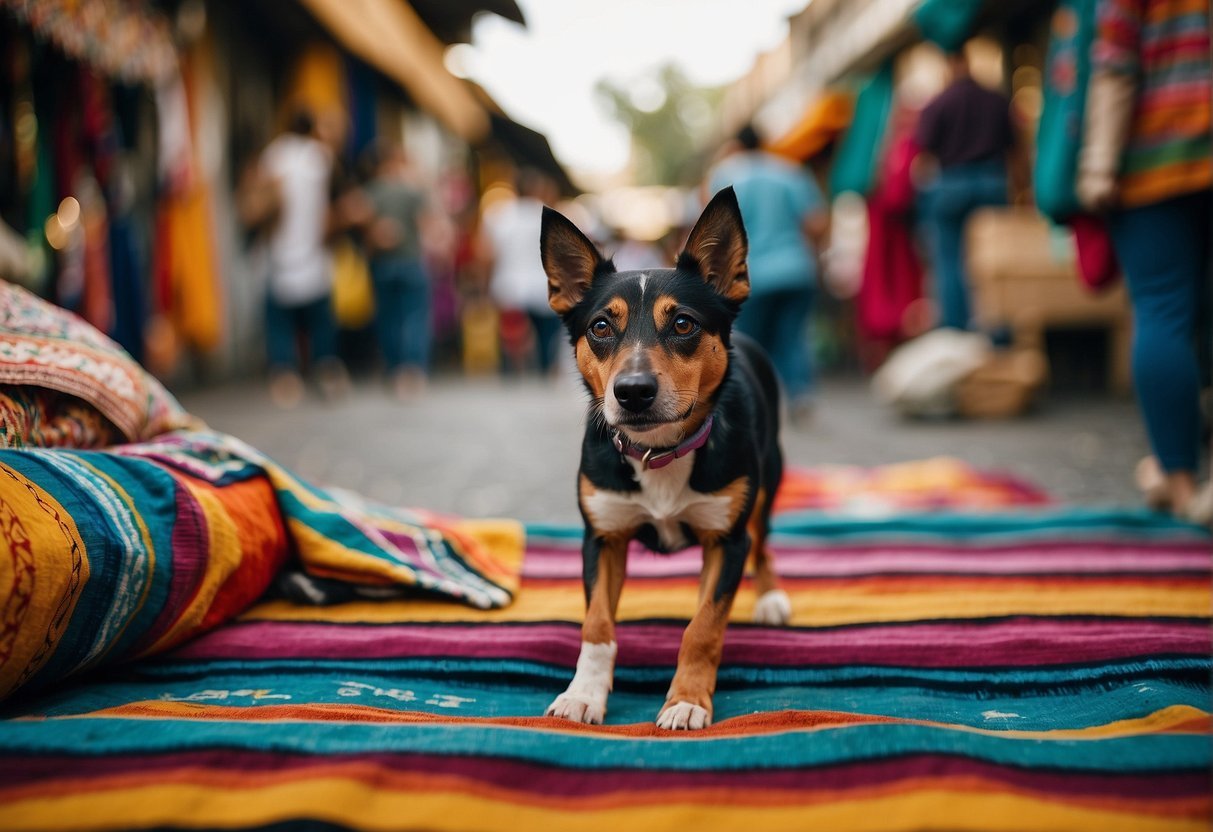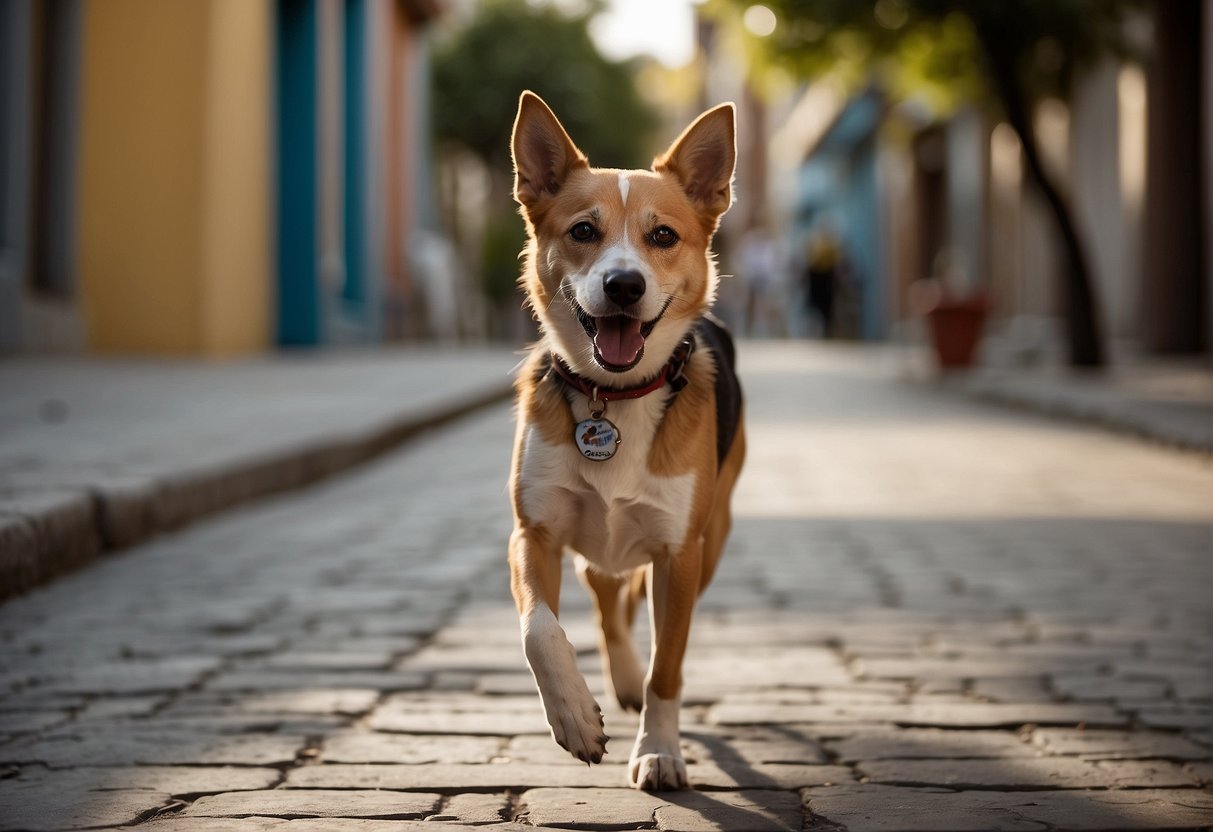Mexican street dogs, also known as free-ranging urban dogs, are a fixture in the local landscape throughout Mexico. These dogs are highly adaptable and resilient. They have evolved to thrive in the diverse and challenging environments of Mexican cities and countrysides.
They exhibit a wide array of physical characteristics because they come from a variety of genetic backgrounds. Some show traits of indigenous breeds, while others display features of more recent European descent.
While often overlooked, Mexican street dogs hold a significant place in Mexican culture. Having been a part of the urban and rural scenery for centuries, these dogs are not only survivors but also companions to those who look past the label of ‘stray’ and choose to welcome them into their homes.
Despite their tough exterior, these dogs often showcase a warm and loyal temperament which endears them to local residents and animal advocates alike.
While some Mexican street dogs may at times find paths to domestic life, many still face numerous challenges. Issues like lack of access to healthcare, food scarcity, and the need for population control are persistent.
History and Origin

The history of the Mexican street dog, commonly known as the callejeros, is steeped in the rich tapestry of Mexico’s cultural past.
Your curiosity about these dogs’ origins takes you back centuries, where indigenous breeds such as the Xoloitzcuintli and the Techichi were already present when Spanish conquistadors arrived.
- Xoloitzcuintli: An ancient breed revered by the Aztecs and known for its significance in mythology and cultural rituals.
- Techichi: A small, silent dog believed to have been kept by the Toltecs, and presumed to be an ancestor to the modern Chihuahua.
In the tumultuous times following the arrival of the Spanish, these indigenous breeds mixed with European dogs, leading to a diverse genetic pool. The Mexican street dog you see today is a product of this diverse heritage and has become a distinctly adaptable and resilient canine.
Historically, these dogs have adapted to a life of independence, which has shaped their traits considerably. They are often friendly and sociable, showing a remarkable ability to bond with their human counterparts, yet they possess the tenacity to survive the harsh realities of street life.
The legacy of the Mexican street dog is a story of survival and adaptation. It reflects the survival of indigenous breeds, the influence of colonization, and the unyielding spirit of dogs that have thrived alongside humans, despite limited intervention.
By understanding their history and origin, you acknowledge the Mexican street dog not as a distinct breed but as a mosaic of Mexico’s canine heritage, resiliently paving its way through history.
Cultural Significance

When you explore Mexican culture, you’ll soon discover the unique role that street dogs, locally known as callejeros, play in the day-to-day life and history of Mexico. These dogs are not just animals wandering the streets; they are a reflection of the resilience and ingenuity inherent in the Mexican spirit.
Mexican Hairless Dog, or Xoloitzcuintli, stands as an icon of national heritage. This breed has been a companion to the Mexican people from the pre-Columbian era and features prominently in folklore and art, signifying its special place in the heart of Mexican society.
For those of you with an interest in herding breeds, such as German Shepherds, you might be intrigued to learn that these dogs, too, have been assimilated into Mexican life, particularly in rural areas where they fulfill vital roles in herding cattle. Their versatile skill set aligns with the historically pragmatic use of dogs in Mexican labor.
Challenges and Welfare
Mexican street dogs face numerous challenges and welfare concerns as they navigate life on the streets. These resilient canines are often the product of neglect and overpopulation, leading to a constant struggle for survival.
| Challenge | Consequences |
|---|---|
| Traffic and Accidents | In urban environments, they contend with heavy traffic, which exposes them to the risk of accidents and injuries. |
| Lack of Veterinary Care | The absence of proper veterinary care makes them vulnerable to diseases such as rabies, parvovirus, and mange. |
| Food Scarcity | They often rely on scavenging through garbage or the kindness of passersby for sustenance, leading to malnutrition and other health issues. |
| Scarce Clean Water | Clean water sources are rare, forcing them to drink from contaminated puddles or polluted rivers. |
| Cruelty and Mistreatment | Some street dogs face cruelty and mistreatment from humans, including abuse and use in dogfighting, which can cause behavioral issues and hinder their adaptation to life as companion animals. |
Despite these challenges, there is hope for Mexican street dogs through the efforts of dedicated animal welfare organizations and rescue groups. These organizations work tirelessly to provide medical care, food, and shelter for stray dogs. They also focus on spay and neuter programs to control the population and reduce the number of dogs born into a life of hardship on the streets.
Physical Characteristics

Appearance
Mexican street dogs are often medium-sized, with a robust and sturdy frame. Their size and build equip them for a life that may require endurance and agility.
These pups display a wide range of physical characteristics; some may resemble the Mexican Hairless (Xoloitzcuintli) in certain traits, while others present a mix of features resembling various breeds.
Coat and Coloring
Their coats can vary significantly, from short to medium-length, often offering a practical layer of protection against environmental factors.
When it comes to coloring, these dogs present a wide range that can include shades of black, white, brown, tan, and sometimes even a mix that results in unique patterns. Their physical resilience is mirrored in their coat’s adaptability to Mexico’s diverse climates.
- Coat Type: Typically short to medium length
- Color Range: Black, white, brown, tan, and mixed patterns
Behavior and Temperament

Mexican street dogs exhibit a range of behaviors and temperaments, many shaped by the necessity to survive in a challenging environment.
You’ll find that these dogs often possess a blend of intelligence, independence, and loyalty. While their affable nature may surprise you, it is essential to understand how their upbringing impacts their interactions.
Training and Socialization
Mexican street dogs have high intelligence, making them capable learners. Effective training strategies involve consistency and positive reinforcement, as these dogs respond well to being rewarded for good behavior.
Obedience training is important for Mexican street dogs and starts with understanding their temperament. Your efforts in socialization can also help them adjust to new environments.
They typically show an affectionate nature alongside their friendly dispositions, but they also retain an independent streak which may require a patient approach. Early and continuous socialization is key to helping them form strong bonds and promote their innate sense of loyalty.
In the Family
These doggos are a diverse and adaptable breed that can make wonderful family pets. They are known for their desire to find a place or home with regular food and companionship, making them loyal and affectionate companions.
They are invariably intelligent, of good temperament, and have strong survival instincts, which can translate to quick learning and adaptability in a family environment.
If you treat them well, they will usually reciprocate.
Health and Care

Just like any other pupper, maintaining the health of your Mexican street dog involves a holistic approach encompassing a balanced diet, regular exercise, consistent grooming, and up-to-date medical care.
Nutritional Needs
Your Mexican street dog requires a diet rich in proteins, carbohydrates, fats, vitamins, and minerals to support their active lifestyle.
The appropriate meal portion depends on their size, age, and activity level.
Adult dogs typically need two meals a day, while puppies may require more frequent feeding.
Exercise Requirements
Regular exercise is crucial for your dog’s physical and mental well-being. Aim for at least 30 minutes to an hour of physical activity daily, which can include walks, runs, or playtime.
An active lifestyle helps prevent obesity and mitigates behavior problems linked to pent-up energy.
Grooming
Mexican street dogs generally have short coats that need minimal grooming. However, routine brushing reduces shedding and keeps their coat healthy.
Additionally, regular nail trims, ear cleanings, and dental care are important to prevent common hygiene-related issues.
Medical Care and Vaccinations
Preventative medical care, including vaccinations, is essential for your dog’s health.
Schedule annual check-ups with your vet and keep up with vaccinations to protect against diseases. Promptly address any signs of illness or injury by consulting a professional.
Ethical Breeding and Ownership

In addressing the plight of Mexican street dogs, ethical breeding and conscientious ownership play pivotal roles. As a potential pet owner or breeder, your actions can promote animal welfare and contribute to resolving the challenges associated with street dog populations.
Responsible Breeding
When considering breeding Mexican street dogs, or any dogs for that matter, it is paramount that you ensure genetic health and prevent overpopulation. It’s not just about breeds like the Chihuahua or German Shepherd, which often have defined standards; it’s about preventing health issues and unwanted litters.
- Prioritize health screenings and genetic testing for parent dogs.
- Limit breeding to avoid contributing to overpopulation.
- Ensure you have suitable homes lined up for future puppies.
Owning a Mexican Street Dog: Adoption and Rescue
Adopting a Mexican street dog comes with the responsibility of providing a secure, loving home. These dogs, when given a chance, can become incredibly loyal companions.
- Be prepared to care for your pet’s physical and emotional needs.
- Rescue dogs may need time to adjust to their new surroundings.
- Commit to your pet for their lifetime. Responsible pet ownership is a long-term commitment.
Here are a few adoption agencies:




